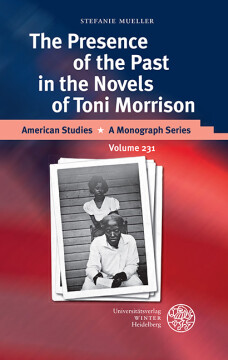
BUCH
The Presence of the Past in the Novels of Toni Morrison
American Studies – A Monograph Series, Bd. 231
2013
Zusätzliche Informationen
Bibliografische Daten
Abstract
After decades of research into the role of memory, trauma, and historiography in her work, to say that Toni Morrison’s novels deal with the presence of the past may seem like a truism. But the Complexity of Morrison’s vision originates in her understanding of the nature of this past as both individual and collective. This study approaches Morrison’s more recent novels on the basis of both literary analysis and sociological theory: drawing on the work of Pierre Bourdieu and Norbert Elias, it shows that the presence of the past in her work unfolds not only in images of memory and trauma, but in her portrayal of a past that is active in bodies, minds, and social institutions. In ‘Paradise’ (1998) and ‘Love’ (2003) this active presence of the past threatens to undermine the African American community from within; in ‘A Mercy’ (2008), Morrison takes us to the symbolic beginnings of structural inequality in the United States. Taking its cue from Pierre Bourdieu’s definition of habitus as ‘presence of the past’, this study shows that in writing about the past Toni Morrison really is exploring the conditions of possibility for the present.
Inhaltsverzeichnis
| Zwischenüberschrift | Seite | Aktion | Preis |
|---|---|---|---|
| Contents | 5 | ||
| Acknowledgments | 7 | ||
| The Presence of the Past – History and Habitus in Toni Morrison’s Novels | 9 | ||
| Thinking Relationally – An Introduction to Pierre Bourdieu and Norbert Elias | 21 | ||
| Fields and Figurations | 26 | ||
| Habitus | 31 | ||
| The Presence of the Past | 41 | ||
| “What for is this difference?” – Established and Outsiders in "Paradise" | 47 | ||
| Narrative Discourse in Paradise | 49 | ||
| Reliability and ‘Group Charisma’ | 49 | ||
| “Communal Subjects” | 56 | ||
| The Image of Paradise | 63 | ||
| The Established-Outsider Figuration in "Paradise" | 66 | ||
| Symbolic Struggles: Constitution and Control | 69 | ||
| The Internal Status Hierarchy | 79 | ||
| The Established and the Outsiders | 87 | ||
| “Family Heirlooms” – The Presence of the Past in Love | 95 | ||
| Narrative Discourse in "Love" | 96 | ||
| L(ove)’s Tale | 96 | ||
| “Memory-and-Junk-Jammed” Spaces | 118 | ||
| “Hidden Constants”: History ‘in Things and in Bodies’ | 128 | ||
| The Body | 129 | ||
| Studying Ways to Contradict History | 133 | ||
| Changing the Blood | 141 | ||
| ‘Postscript on Love’ | 148 | ||
| “Orphans, each and all” – The Formation of the Past in "A Mercy" | 159 | ||
| Narrative Discourse in "A Mercy" | 160 | ||
| The Crisis of Now | 160 | ||
| "A Mercy" and Neo-Slave Narratives | 170 | ||
| Learning to Read the Wor(l)d | 172 | ||
| Demons and Minions | 176 | ||
| Mothers and Birds | 179 | ||
| The House of Jacob | 186 | ||
| The Logic of Property | 190 | ||
| Longing and Belonging | 200 | ||
| "Beloved": Breaking the Back of Words | 211 | ||
| Epilogue: Toni Morrison and the Literary Field | 229 | ||
| Pierre Bourdieu and "The Rules of Art" | 231 | ||
| African American Authors in the Literary Field | 235 | ||
| ‘The work must be political’ | 243 | ||
| ‘Certainly no clamor for a kiss’ | 247 | ||
| The Consecrated Avant-garde | 251 | ||
| Toni Morrison and the Intellectual Field | 255 | ||
| Bibliography | 261 |


 Publishing Platform by CloudPublish
Publishing Platform by CloudPublish